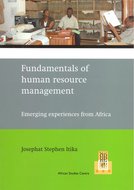Josephat Stephen Itika ~ Fundamentals Of Human Resource Management: Emerging Experiences From Africa
No Comments yet ‘Leaders must be guided by rules which lead to success.’ (Machiavelli: The Prince)
‘Leaders must be guided by rules which lead to success.’ (Machiavelli: The Prince)
Foreword
For over half a century now, most African people south of the Sahara are still living under political, social and economic hardships, which cannot be compared with the rest of the world. For many, the expectations of independence have remained a dream. This state of affairs has many explanations but it is fundamentally based on the nature of African countries and organisations on one hand, and on the other hand there is over reliance on Eurocentric philosophies, theories, and assumptions on how administrators and managers should manage African countries, organisations, and people in such a way that will lead to prosperity. As a result, the same Eurocentric mindsets are used to develop solutions for African leaders and managers through knowledge codification and dissemination in the form of textbooks and the curricula in education systems.
Evidence from economies in South East Asian countries suggests that the success behind these countries is largely explained by high investment in human capital and, to some extent, avoiding wholesale reliance on the importing of northern concepts, values and ways of managing people; that is, the development of human resources capable of demonstrating management in setting and pursuing national, sector wide, and corporate vision, strategies, and commitment to a common cause within the context of their own countries and organisations. Similarly, African managers and leaders effectively cannot manage by merely importing Eurocentric knowledge without critical reflection, sorting and adaptation to suit the context they work in and with cautious understanding of the implications of globalisation in their day-to-day management practices. They have to understand and carefully interpret northern concepts and embedded assumptions, internalise and develop the best strategies and techniques for using them to address management problems in their organisations and countries, which are, by and large, Afrocentric.
Therefore, like Machiavelli, human resource managers, like leaders, must be guided by rules which lead to the success of their countries and organisations. The main challenge facing human resource managers now is to know which rules are necessary and when applied would lead to effective human resource management results in different types of public and private sector organisations and contexts. This is a difficult question to answer. However, we can start by learning one small step at a time from the emerging experiences of our own practices of human resource management in Africa and elsewhere.
This book on ‘Fundamentals of human resource management: Emerging Experiences from African Countries’ has just made a small step in the journey of establishing a link between Eurocentric concepts, philosophies, values, theories, principles and techniques in human resource management and understanding of what is happening in African organisations. This will form part of the groundwork of unpacking what works and what does not work well in African organisational contexts and shed more light on emerging synergistic lessons for the future. The book has fourteen chapters each addressing important issues in human resource management in terms of the Eurocentric approach and reflecting on what is happening in African governments and organisations at the end of each chapter.
Chapter 1 starts to lay the foundations of human resource management, on which the rest of the book is anchored. It covers theoretical issues and historical trends in the evolution and development of human resource management as a discipline and a profession.
Chapter 2 sets the basis for using a strategic approach to manage human resources and the link between corporate strategy and strategic human resource management. It establishes the changing role of human resource managers from that of managing routine functions into a strategic business partner where human resource management functions are decentralised to lower departments and sections.
Chapter 3 is concerned with human resource policies as the step following strategic choices in people management. Policies are useful in guiding managers to ensure that organisations have the right number and quality of staff at any particular point in time.
Chapter 4 covers the fundamentals of employee resourcing and addresses key issues in human resource planning at micro, meso and macro level. It also considers challenges facing management on decision making in financing human resource plans.
Chapter 5 investigates recruitment and selection. Our experience is that all managers and administrators are involved in one way or another in human resource recruitment and selection and require knowledge, skills and techniques for getting people into organisations. Special emphasis is put on the use of appropriate selection techniques and tools, particularly assessment centres. The most successful organisations have the best strategies to utilise staff and measure their performance.
This is covered in chapter 6, which is devoted to performance management systems, processes, techniques and measurements. There is always a link between reward and performance. The employee’s performance should be recognised through the provision of appropriate rewards.
Chapter 7 describes the development of appropriate reward systems for effectively utilising human resources.
Chapter 8 is about human resource development partly as recognition that improved performance is achieved through continuous training and development but also that training and development are essential rewards. When employees join organisations they have their own needs, expectations and interests as individuals and as a part of a team. Likewise, employers do not engage staff without needs, expectations and interests to be met and which may not necessarily be compatible with those of the employees. Therefore, the relationship between these two parties has to be effectively managed in order to have a harmonious work place.
Chapter 9 is devoted to the relationship employees have with their management. With globalisation and the emergence of many multinational corporations, managing human resource, which is diverse in nature within multinationals, is of increasing concern for managers. Therefore, the legal framework which governs the relationships between employees, employers and trade union in Tanzania is given emphasis. One of the strongly emerging developments in human resource management discipline is a shift from traditional human resource management to competency based human resource management whereby the identification, utilisation, rewarding, measurement and developing of talents and competencies are becoming critical in determining
organisational competitiveness and sustainability.
Therefore, chapter 10 underscores the importance of talent and competency based human resource management in competitive organisations.
The ongoing reforms in both public and private sector organisations and the efforts to promote foreign direct investment in Africa have started to bear fruits that pose many challenges on managing multicultural workforce.
Chapter 11 looks at the international perspectives of human resource management as recognition of the emerging challenges and emphasis on the need to re-examine the best ways to manage people in a globalise world.
Chapter 12 is more practical and based Tanzanian experiences. It focuses on the link between recruitment and open performance appraisal in Tanzanian public service by identifying the mismatch between recruitment and selection and open performance appraisal and recommends an alternative model.
Chapter 13 links theory and practice in human resource management for health in general and more specifically in local authorities in Tanzania. The main focus is on recruitment and retention strategies and the challenges faced in health service provision.
Chapter 14 is on the human resource management in a private foreign company for the purposes of drawing lessons from other private sector organisations that are now the engine of economic growth in Tanzania. The chapter covers policies and procedures governing day-to-day people management.
It will be noted with emphasis that in each chapter there is a reflection on what is going on in some Tanzanian and other African countries and organisations. It is important that readers make use of these lessons to digest the usefulness of northern concepts, theories, assumptions and principles and how they may be better utilised within the context of their own countries. For those interested in academia, it will be a starting point to begin building models for human resource management particularly for Sub Saharan Africa.
‘For every effect there is a cause. The prime mover and the work of men is to change it.’ (Aristotle, 384-322 BC)
Prof. Josephat Stephen Itika (PhD)
School of Public Administration and Management, Mzumbe University, Tanzania
Download book: https://openaccess.leidenuniv.nl/075287668-3030-01.pdf?sequence=2
ISBN 978-90-5448-108-9 – 2011 – African Public Administration and Management Series 2
You May Also Like
Comments
Leave a Reply







